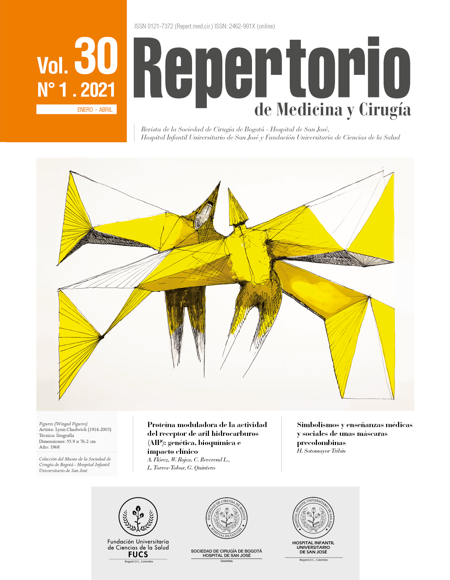Symbolisms and medical and social teachings of some pre-columbian masks
Simbolismos y enseñanzas médicas y sociales de unas máscaras precolombinas
![]()
![]()

Show authors biography
Four pre-Columbian masks are presented, three of which are Ecuadorian and one Colombian. The Ecuadorian masks are made of ceramics and ascribe to the Jama-Coaque culture and the third is made of Spondylus prínceps shell, and does not have any ascription to any particular Ecuadorian pre-Hispanic coastal culture, for no systematic study was conducted in Ecuador on the relationship of those masks and coastal cultures. The Colombian mask is made of copper. The first ceramic mask, for its size, weight and additional elements – a white material that simulates teeth, three green stones that simulate eyes and a lower labial incrustation, “bezote”- makes one recall a death mask of an individual with significant power and high social status; the second ceramic mask, features sixteen facial nodules which refer the observer to the Peruvian wart or bartonellosis, the third mask was possibly created as a volitional or offering element to exhibit power or evoke the force or protection given the great symbolic value of that red shell. The middle Cauca Quimbaya copper mask was most probably used as an ornament for the chest of a powerful or high class person given its material, weight and color. The mask that resembles bartonellosis is compared with other two masks the author had already examined. The shell mask was compared with another made of the same type of shell, the copper mask with a small jadeite stone mask, a masked skull that the author had the opportunity to examine several years ago. Finally, these interpretations suggest that in addition to the uses traditionally assigned to the masks: festive, funerary and as body adornments to portray the power of the wearer, the masks with the multiple nodular lesions must have served a role similar to that of the ceramic and stone miniature statues which depict pathologies, featuring great realism in pre-Hispanic art, as a way of teaching through an analogical empirical medical thought, the same role played by wax molds, photographs and drawings and paintings in modern medicine, also based on analytical empirical thought.
Article visits 962 | PDF visits 758
Downloads
1. Sotomayor Tribín HA. A propósito de la Bartonelosis en una Máscara Ecuatoriana Precolombina. Revista Medicina. 1994;16(2):28-9.
2. Sotomayor Tribín HA, Correal Urrego G. Las calaveras enmascaradas de las momias Yuko-Yukpa (Motilones). Revista de la Academia Colombiana de Ciencias Exactas, Fisicas y Naturales. 2003;27(102):5-14.
3. Sotomayor Tribín HA. Aspectos históricos y geográficos de algunas enfermedades importantes en Colombia. Bogotá: Universidad Militar Nueva Granada; 2012.
4. Chávez Mendoza Á. Máscara precolombina. Bogotá: Ediciones Zazacuabi; 1977.
5. Restrepo De León A. Los rostros de la mar. Bogotá: Inédito; 2017.
6. Quinatoa Cotacachi E. Representaciones ancestrales y colores del cosmos: diseños de platos del Carchi. Colombia: Ministerio de Cultura y Patrimonio; 2013.
7. Museo Nacional del Banco Central del Ecuador. Jama-Coaque en la Guía de la sala de arqueología. Quito: Banco Central del Ecuador; 2001. p. 62.
8. Botero CI. Museo del Oro. Bogotá: Banco de la República; 2008. p. 91-103.
9. de León C. La crónica del Perú. Madrid: Historia 16; 1984.
10. Garcilaso de la Vega I. Historia General del Perú. In: Oviedo JM, editor. La edad del oro Crónicas y testimonios de la conquista del Perú. Barcelona: Tusquet; 1986. p. 205.
11. Flores E, Cevallos L, Burstein Z. Historia de la dermatología en Perú. In: Galimberti R, Pierini A, Cervini A, editors. Historia de la Dermatología Latinoamericana. Toulouse: Ed Privat; 2007. p. 307-64.
12. Sotomayor Tribín HA. Memorias del II Congreso Peruano de Genética y XVI Latinoamericano de Genética. Descripción de enfermedades genéticas en cerámicas prehispánicas de la Cultura Tumaco - La Tolita. Lima Perú1989.
13. Sotomayor Tribín HA. Enfermedades en el arte prehispanico colombiano. Boletín Museo del Oro. 1991;29:63-73.
14. Sotomayor Tribín HA. Arte tumaco y medicina indígena prehispánica en Colombia. Pediatría. 1991;25(1).
15. Sotomayor Tribín HA. Arte indígena prehispánico colombiano y enfermedades. Pediatría. 1991;26(1).
16. Sotomayor Tribin HA. Iconografía del dolor, la enfermedad y la Muerte en la Cultura Precolombina de Tumaco. La Tolit. Revista Medicina. 1992;14(4):35-7.
17. Sotomayor Tribín HA. Arqueomedicina de Colombia Prehispánica. Bogotá: Cafam-Comisión V Centenario; 1992.
18. Sotomayor Tribín HA. Enfermedades y símbolos de poder y trascendencia en cerámicas prehispánicas colombianas. Pediatría. 1993;28:63-73.
19. Sotomayor Tribín HA, Correal Urrego G. Iconografía de patologías en la colección de orfebrería del Museo del Oro del Banco de la República. Boletín Museo del Oro. 1995(38-39):172-5.
20. Sotomayor Tribín HA. Arqueomedicina de Colombia prehispánica. Bogotá: Edifarni; 1999.
21. Sotomayor Tribín HA, Cuéllar-Montoya Z. Aproximaciones a la paleopatología en América Latina. Colombia: Academia Nacional de Medicina de Colombia; 2007.
22. Sotomayor Tribín HA. Enano y gigantes en mitologías indígenas y la arqueología de Colombia. Repert Med Cir. 2007;16(2):96-104. doi: 10.31260/REPERTMEDCIR.V16.N2.2007.466
23. Sotomayor Tribín HA. Enanismo: Representaciones artísticas en Amŕeica prehispánica y otras sociedades. Repert Med Cir. 2014;23(4):299-313. doi: 10.31260/REPERTMEDCIR.V23.N4.2014.702
24. Sotomayor Tribín HA. Pensamiento analógico mítico en la interpretación del arte prehispánico de interés para la arqueomedicina y la paleopatología. Repert Med Cir. 2016;2(1):59-71. doi: 10.1016/j.reper.2016.02.013












